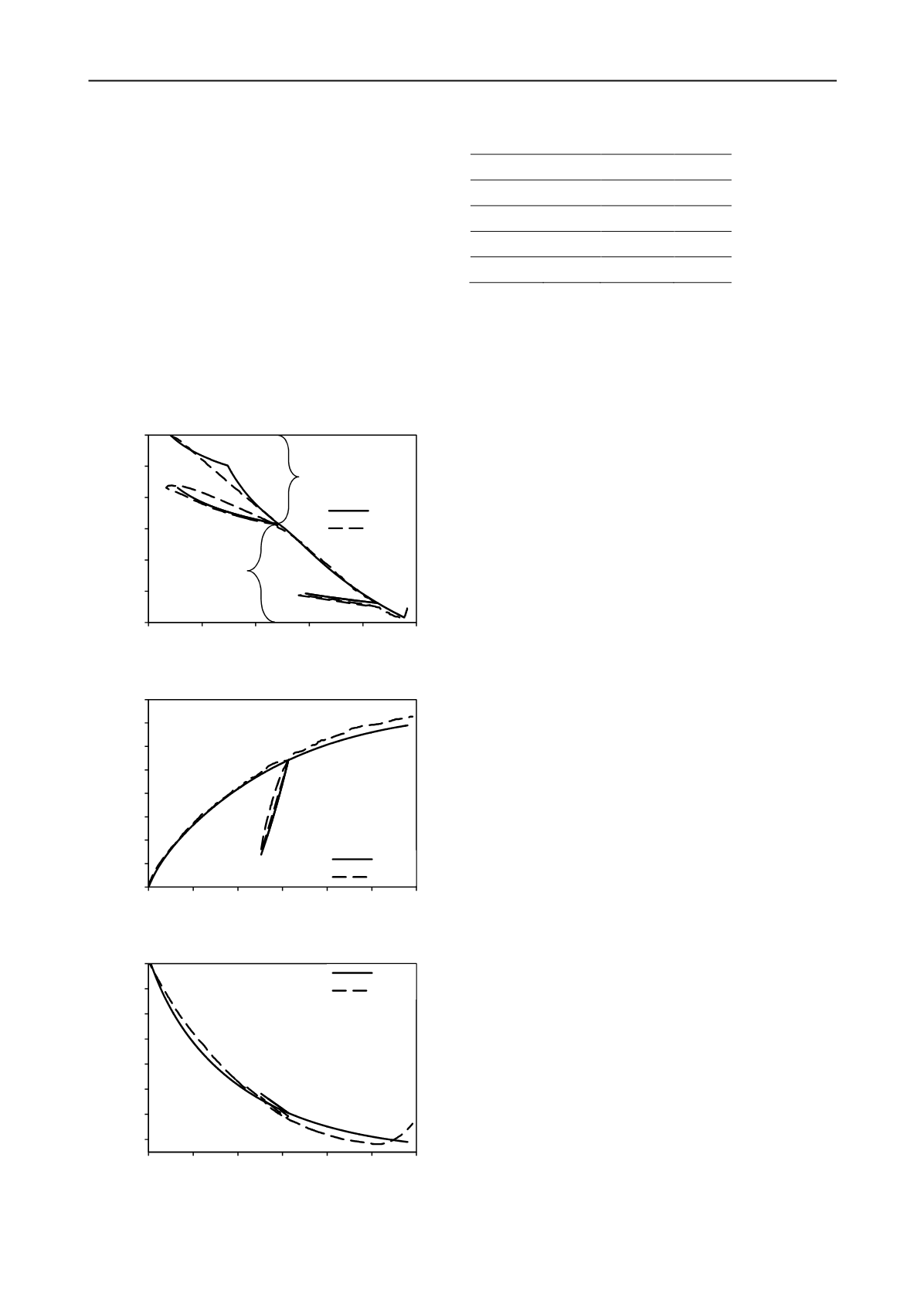
780
Proceedings of the 18
th
International Conference on Soil Mechanics and Geotechnical Engineering, Paris 2013
The following iteration started with the random generation of
more 25% of individuals, always using the limits presented in
Table 1. After a random process where pairs of parents were
formed, the crossover of the individuals was done with
“alternate with variable probability crossing” method (Taborda
et al. 2008, cited by Azeiteiro 2008). The other 50% of
individuals were generated by this manner, using the
information of their progenitors.
FLAC was used to test the 75% new individuals, which were
evaluated using the procedure of measure the areas between the
numerical and the experimental curves. After this, a new HC
was applied only to the 25% best individuals, and the rest of the
procedure was repeated until 150 iterations. A visual validation
of the results was done.
The final results are presented in Figure 4 for all the spaces
considered, namely (i)
, (ii)
and (iii)
. The
final parameters are in the Table 2. A good agreement was found
between the numerical and the experimental data of test 12.
Figure 4. Comparison between the results obtained by the constitutive
model and the test 12: a)
ε
v
−
p, b)
ε
q
−
q and c)
ε
q
− ε
v
.
Table 2. Final parameters for the model.
Parameter
Value
Parameter
Value
0.0041
2.059
0.0111
,
7396.5
1.414
,
2480.1
0.284
0.304
5 CONCLUSIONS
The constitutive model for HSSR used to simulate the
behaviour of Abadia Marls requires 9 calibration parameters.
Their calibration was done by fitting numerical results to
experimental curve using a Genetic Algorithm with Hill
Climbing procedure implemented in MATLAB. The physical
meaning of the parameters was ensured by a proper definition of
their search limits.
The simulation of the triaxial test on one specimen subjected
to isotropic compression until reaching 12MPa, followed by
shear until almost 35MPa, was done using FLAC. The
comparison between the numerical and the experimental results
shows a good agreement. This proves that this type of
algorithms can be used in the determination of numerical
parameters of constitutive models.
The link between MATLAB and FLAC used as
complementary numerical tools provides great flexibility to this
type of algorithms, for the determination of parameters of
constitutive models with results from any experimental test.
6 REFERENCES
Alonso, E.E., Pereira, J.-M., Vaunat, J. and Olivella, S. 2010.
A
microstructurally-based effective stress for unsaturated soils
.
Géotechnique, 60(12), pp. 913-925.
Azeiteiro R.N. 2008.
Application of genetic algorithms to calibrate soil
behaviour models
. Master Thesis, Faculty of Sciences and
Technology, University of Coimbra (in Portuguese).
Cardoso R. 2009.
Hydro-mechanical behaviour of compacted marls
. PhD
Thesis, Instituto Superior Técnico, Lisbon Technical University.
Gens A. and Nova R. 1993. Conceptual bases for a constitutive model
for bonded soils and weak rocks.
Geotechnical Engineering of
Hard Soils – Soft Rocks
, 485-494, Balkema, Rotterdam,
Hashiguchi K. 2009. Elastoplasticity theory.
Lecture Notes in Applied
and Computational Mechanics
, Volume 42, Springer.
Kavvadas M. and Belokas G. 2001. An anisotropic elastoplastic
constitutive model for natural soils.
Computer Methods and
Advances in Geomechanics
, 335-340, Balkema, Rotterdam.
Muralha J., Cardoso R., Maranha das Neves E. and Caldeira L. 2011.
Hydro-mechanical characterization of Jurassic marls to study load
degradation.
Proc. XV European Conference on Soil Mechanics
and Geotechnical Engineering
, 647-652, Athens, Greece.
Nova R. 2005. A simple elastoplastic model for soils and soft rock. In
Soil Constitutive Models: Evaluation, Selection and Calibration
,
ASCE, Geotechnical Special Publication, No. 128, 380-399.
Pal S., Wathugala G. and Kundu S. 1996. Calibration of a constitutive
model using genetic algorithm.
Computers and Geotechnics
, 19(4),
325-348.
Renders J.M. and Bersini H. 1994. Hybridizing genetic algorithms with
hill-climbing methods for global optimization: Two possible ways.
Proceedings of the First IEEE Conference on Evolutionary
Computation
, Orlando, FL, USA. Vol. 1, 312-317.
Taborda D.M.G., Pedro A., Coelho P.A.L.F. and Antunes D. 2011.
Impact of the integration of a hill climbing procedure on the
performance of a genetic algorithms-based software.
Proc. 2
nd
International Symposium on Computational Geomechanics –
COMGEO II, Cavtat, Croatia, International Centre for
Computational Engineering.
Taborda D.M.G., Coelho P. A.L.F, Antunes D. and Antonio P. 2008.
Genetic algorithms as a calibration method for constitutive models.
XI Congresso Nacional de Geotecnia
, Portugal (in Portuguese).
0
5
10
15
20
25
30
0
5
10
15
20
25
ε
v
(10
-3
)
p
(MPa)
Model
Test 12
0
5
10
15
20
25
30
35
40
0
5
10
15
20
25
30
q
(MPa)
ε
q
(10
-3
)
Model
Test 12
15
17
19
21
23
25
27
29
0
5
10
15
20
25
30
ε
v
(10
-3
)
ε
q
(10
-3
)
Model
Test 12
a)
b)
c)
isotropic
phase
shear
phase


